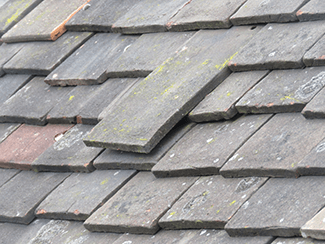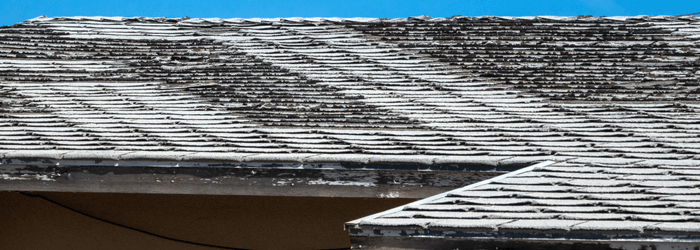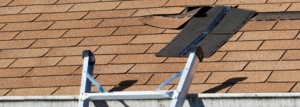“Most roofs fail because we don’t take care of our roofs as well as we should,” says Tyler Johnson of Johnson Roofing, a Rosie on the House Certified Partner.
By not taking care of our roof as we should, it will likely not last anywhere as long as it should. We cannot reinforce enough how important it is to budget for regular maintenance and potential repairs of our roofs.
Age Limiting Factors
Lack of proper maintenance is not the only reason our roof can deteriorate over time. Age-limiting factors come into play as well. Some roofing products use VOCs in their manufacturing products. VOCs are Volatile Organic Compounds. We often hear about VOCs concerning the odors associated with paint fumes. These compounds are “off-gassed” into the environment and leave a product that deteriorates over time. That is what is meant by “age-limiting factors.” Asphalt shingle roofs direct exposure to the elements (sun, storms, wind, and debris build-up) makes them especially prone to that kind of deterioration.
A roof system is only as good as its components. While concrete tiles, or even terra cotta tiles, last well beyond our lifetimes, the products used to support them and further protect the roof can contribute to the roof system’s failure sooner.
Of note is the underlayment system of a tile roof. Typically, a 30 or 40-pound asphalt-impregnated felt is used as an underlayment, which can last 20 to 30 years. Tile, as we said, can last for hundreds of years. So, when your contractor sits down to discuss roof components in detail (which Tyler insists they should), pay close attention to the components of the proposed roofing system.
Tyler points out that putting an underlayment system down that is designed to last approximately one-tenth of the roof cover is not in your best interest. He tells his clients that doubling the underlayment system may add 15 to 20 percent to the initial cost. That increased expense is marginal compared to the cost of removing the tiles, the battens, and the underlayment in 20 years. Pretty sound reasoning, we think!
“We also recommend using an asphalt-impregnated felt as underlayment. Synthetics don’t seem to seal around nail penetrations as well as the felt,” says Tyler.
Taking Care of Your Roof
Inspection
 The first step to taking care of your roof is to visually inspect it periodically, particularly after a heavy storm such as a monsoon can generate. Look for anomalies like missing, broken, or loose tiles. Repairs from storm damage may be covered under your homeowner’s insurance policy. More importantly, you now have the opportunity to address an issue before it becomes a major repair.
The first step to taking care of your roof is to visually inspect it periodically, particularly after a heavy storm such as a monsoon can generate. Look for anomalies like missing, broken, or loose tiles. Repairs from storm damage may be covered under your homeowner’s insurance policy. More importantly, you now have the opportunity to address an issue before it becomes a major repair.
We don’t recommend climbing on your roof. However, if you are going to inspect the roof yourself, several safety factors need to be followed.
- Most importantly, make sure your ladder is sturdy.
- Once you are on the roof, be careful how you step on the tiles so as not to break them or cause further damage. Stepping carefully, using the balls of your feet, place your weight slowly on the bottom third of the exposed tile.
- If you don’t feel confident getting on the roof, a professional, ROC-licensed, trusted roofer can provide an assessment.
We have heard some folks inspecting their roofs from the ground with a pair of binoculars. Tyler doesn’t recommend this as the only form of inspection because too many things can be missed. The upside of a chimney may not be visible, and other roof features may block a complete visual inspection. “Eyes on” are the key here. Also, the smaller cracks in any roof system can go unnoticed until they become bigger problems.
Flashing
 Some other aspects of your roofing system you should look for, usually during a routine annual inspection, are the flashing connections. Look for flashing coming off the surface it is connected to. There are several penetrations on your roof as well. Several of them are the vents for the plumbing or HVAC systems. There is a flashing piece around them referred to as a “roof jack.” These are specifically designed to prevent water infiltration around the roof penetrations. The seal around the pipe can deteriorate over time, (again, age-limiting factors). Replacing these as needed can prevent leaks from occurring.
Some other aspects of your roofing system you should look for, usually during a routine annual inspection, are the flashing connections. Look for flashing coming off the surface it is connected to. There are several penetrations on your roof as well. Several of them are the vents for the plumbing or HVAC systems. There is a flashing piece around them referred to as a “roof jack.” These are specifically designed to prevent water infiltration around the roof penetrations. The seal around the pipe can deteriorate over time, (again, age-limiting factors). Replacing these as needed can prevent leaks from occurring.
Removing Debris
Removing debris from your gutters is important because items from trees can collect in valleys. In some parts of Arizona, pack rats and other critters can take up residency in the spaces between the underside of the tile and the underlayment. Make sure all the access points to this space are sealed well.
Tyler leaves us with this caution: “the tiniest flaw, left unaddressed, can and most likely, will turn into a major fix. Take care of your roof, and it will take care of you.”
Tarping A Flat Roof
This time we literally put Rosie, on the house! Watch him with Tyler Johnson of Johnson Roofing talking about what to do if you end up with a leak in your flat roof. Spoiler – you can’t tarp it – but learn what you can do!
###
Content Partner | Johnson Roofing

Since 2004 Johnson Roofing has been offering the highest quality roofing services in the Valley of the Sun. You can feel confident that you are getting not only the most professional service available, but the best pricing for your particular need. Johnson Roofing specializes in roofing repairs, replacements, and new roof installations. Doesn’t matter if it is residential, commercial, or industrial, Johnson Roofing can assist you with any home roofing need.
PODCAST
Debris on the roof, thermal shock, flat roof cracks, loose shingles and tiles can lead to roof failure. Tyler Johnson of Johnson Roofing says the key to a long lasting roof is maintenance. It can even keep the warranty in effect. Pros and cons on synthetic underlay versus regular felt and other signs to look for if the roof needs attention.
Podcast Archive With Expanded Content and Resources
PHOTO CREDIT
- Shutterstock



















